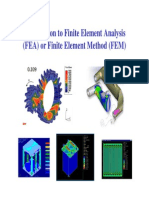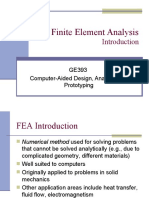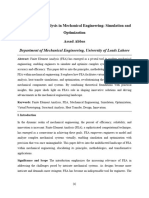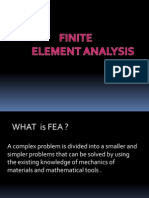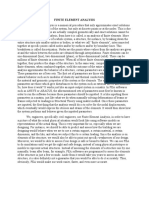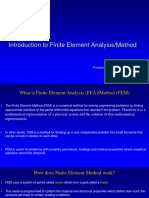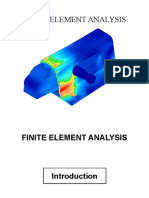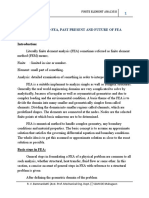Introduction to Finite Element Analysis (FEA) Filename: Introduction_to_Finite_Element_Analysis.
pdf
Topic: A foundational guide to the theory and application of FEA for stress analysis.
Content:
Introduction to Finite Element Analysis (FEA) A Primer for Mechanical Engineers
Abstract: Finite Element Analysis is a computational method for predicting how a product reacts to real-
world forces, vibration, heat, fluid flow, and other physical effects. This document provides a high-level
overview of the core principles, process, and applications of FEA.
1. What is FEA? FEA is a numerical technique used to find approximate solutions to boundary value
problems for partial differential equations. In simpler terms, it breaks down a complex real-world
object into a large number (thousands to millions) of small, simple pieces called elements. The
behavior of these individual elements is well-defined through mathematical equations. These
elements are connected at points called nodes, creating a "mesh." The collective behavior of all
elements provides an approximate solution for the entire structure.
Key Concept: "Divide and Conquer." A complex problem is subdivided into smaller, solvable problems.
1. The Core Steps of an FEA Workflow Pre-Processing:
2. Geometry: Import or create the CAD model.
3. Meshing: Discretize the geometry into elements (e.g., tetrahedrons, hexahedrons). Mesh quality is
critical for accuracy.
4. Material Properties: Define properties (Young's Modulus, Poisson's Ratio, density).
5. Boundary Conditions: Apply constraints (fixtures, supports) and loads (forces, pressures).
6. Optional: Simplify geometry to reduce computation time, ensure symmetry if applicable.
Solving: - The solver computes the response (displacements, stresses, temperatures) at each node by
assembling and solving a giant system of equations [K]{u} = {F}, where: - [K] is the global stiffness matrix
(properties + geometry) - {u} is the nodal displacement vector (the unknown we solve for) - {F} is the nodal
force vector (the applied loads) - Iterative solvers may be used for large systems to improve efficiency.
Post-Processing: - Analyze the results using contour plots (e.g., von Mises stress, displacement), animations,
and graphs. - Identify critical areas of high stress or large deformation and compare against material failure
criteria (e.g., yield strength). - Validate results and adjust mesh refinement as needed.
1. Common Types of Analysis
2. Static Structural: Analysis of structures under steady loading conditions.
3. Modal Analysis: Determines the natural vibration frequencies and mode shapes of a structure.
4. Thermal Analysis: Calculates temperature distribution and heat flow.
5. Transient Dynamic: Analysis of structures under time-varying loads.
6. Buckling Analysis: Evaluates stability and critical loads for slender structures.
7. Best Practices and Limitations
1
� 8. Always validate FEA results with hand calculations or experimental data.
9. Understand that FEA provides an approximate solution. The accuracy depends on mesh density,
element type, and correct boundary conditions.
10. The "Garbage In, Garbage Out" (GIGO) principle is paramount. Incorrect inputs lead to meaningless
results.
11. Document all assumptions, simplifications, and boundary conditions clearly for reproducibility.


















